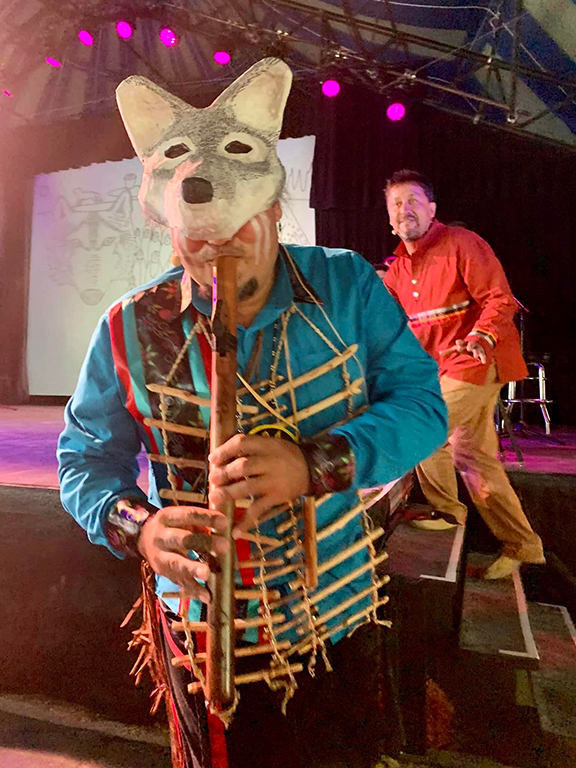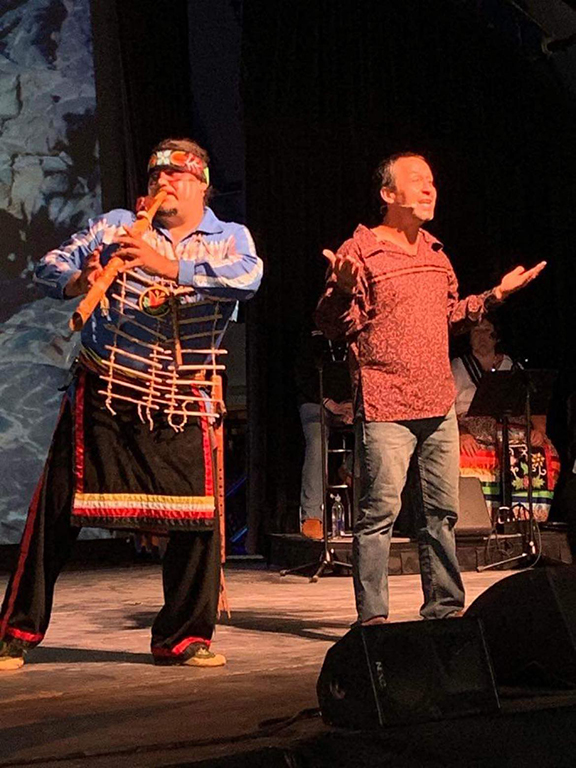
By Winona LaDuke
Say you dreamed up an Anishinaabe musical, forty or so musicians, actors and dancers and had some epic stories to tell. That’s a snap shot of Anishinaabe Dibaajimowan, an Anishinaabe Story, featured in Bayfield, Wisc. at the Big Top Chautauqua.
Michael Laughing Fox Charette had such a dream. And in the heart of the pandemic, the dream gathered power, from tobacco to zoom to stage, into what is one of the most extraordinary plays I have seen. The play lifted hearts and stories in a time of immense change and uncertainty in our world. That, in itself, is a gift.
I caught up with Charette on Madeline Island where we spoke about his monumental tribute to Anishinaabe. He said, “Big Tops Chautauqua’s director [Terry Matier] approached me, asking if I thought we could have a show about the Indigenous culture. I thought that was a good idea considering what our current events were at this time in our history, ie: the deaths of George Floyd and Jason Pero [from Bad River at the hands of police].”
In many ways, this gift also came with Charette’s sobriety – six months without alcohol and the guy writes a 40 person cast, bi-lingual musical. That’s a pretty good testimony as to the potential of a sober Indian person.
“We were given spiritual tools to help us heal. Those tools reside in our language stories and culture,” Charette said.
In the musical play, Creation stories were told. Dylan Jennings, in an eloquent oratory, shares about the origin of agreements and treaties, and “We learn about the first treaty between Anishinaabe and Creator.”

Then there’s the song of the real names of the Apostle Islands, islands which should be returned to the Anishinaabe by the National Park Service. The song comes from a soulful Kevin Soulier, and was sung in Anishinaabemowin by Lyz Jaakola and Lisa Clements. A second version of “Say their Names” came later with Keith Secola’s song of the same name, and the story of the Indian boarding schools.
Breathtaking music, stories and backgrounds, featuring Rabbitt Strickland’s art, videos and photos (old and new) filled the audience with a depth of appreciation, in a diverse and moving production.
In the midst of it Robert Buffalo (Hereditary Chief of Red Cliff Nation in Wisconsin) told the story of his great grandfather, Chief Buffalo. Buffalo, after witnessing the death of 400 Anishinaabe at Sandy Lake, went to Washington to meet with President Fillmore. Buffalo (then 92-years-old) was able to stop the Anishinaabe removal and help establish reservation boundaries, and retain the Anishinaabe people’s rights to hunt, fish, and gather in the ceded territories. That’s why they are still there at Red Cliff. The story, like the family, transcends generations.
Marty Curry, another gifted Anishinaabe man, shared his storytelling style, which was born from a survivor’s ability to act and years on Stage North. This was a new space for Curry, who told me, “I was asked to be a part of it and I was nervous because there was a language component and language was not a strength of mine. Lisa Clements did translations and scripting and gave me guidance on that and it made it much easier.”
The two-night premiere at Big Top, held last summer, was followed by another show this year in June, filling the hearts and minds with appreciation for a land and the people. It left me hungry for more.
For those who performed, it was also healing, and much of the audience resonated and understood this. Martin Curry said, “Part of it for me was being accepted as an Indian man. I was both being acknowledged by my peers and I was accepting that as an Indian Man, I have standing. And to be able to express myself through this lens that Scooter (Charette) created… but no big pressure… I was just playing Wenaboozhoo.”
“It was pretty healing for me, there were several times when I teared up… when I cried, and it felt right… Native men, we have to be different things to different people, it’s kind of like acting. That’s where identity, and the identity of these stories, is so profound. You are a storyteller. You are someone who cries, who is angry… You can be all of these things and it’s acceptable. That’s the great thing about theater.”
The Anishinaabe Dibaajimowin was a spirit lifting joy for all of us. I hope it becomes part of the regular rotation of Big Top and finds a similar home in Duluth, Minneapolis and beyond.
The next performance will take place on Sept. 16 at the Big Top Chautauqua, 32525 Ski Hill Rd, Bayfield, WI. Show begins at 7pm. For info, call 715-373-5552 or 888-244-9368. Or see: https://www.travelwisconsin.com/events/performing-arts/anishinaabe-dibaajimowin-an-ojibwe-story-214342.






